Volume 25, Number 12—December 2019
Synopsis
Global Epidemiology of Buruli Ulcer, 2010–2017, and Analysis of 2014 WHO Programmatic Targets
Figure 2

Figure 2. Dynamics of Buruli ulcer epidemiology by cases reported to the World Health Organization (WHO) in 2010–2017. A) Globally, reported cases declined over time, but the proportion of cases reported from WPRO increased. B) WPRO data show an increase in cases in Australia. C) In AFRO, cases drastically declined in Côte d’Ivoire but recently increased in other countries such as Ghana, Nigeria, and Liberia. D) Countries in AFRO that reported fewer cases overall showed stagnant or varying numbers. AFRO, WHO African Region; WPRO, WHO Western Pacific Region.
Page created: November 18, 2019
Page updated: November 18, 2019
Page reviewed: November 18, 2019
The conclusions, findings, and opinions expressed by authors contributing to this journal do not necessarily reflect the official position of the U.S. Department of Health and Human Services, the Public Health Service, the Centers for Disease Control and Prevention, or the authors' affiliated institutions. Use of trade names is for identification only and does not imply endorsement by any of the groups named above.